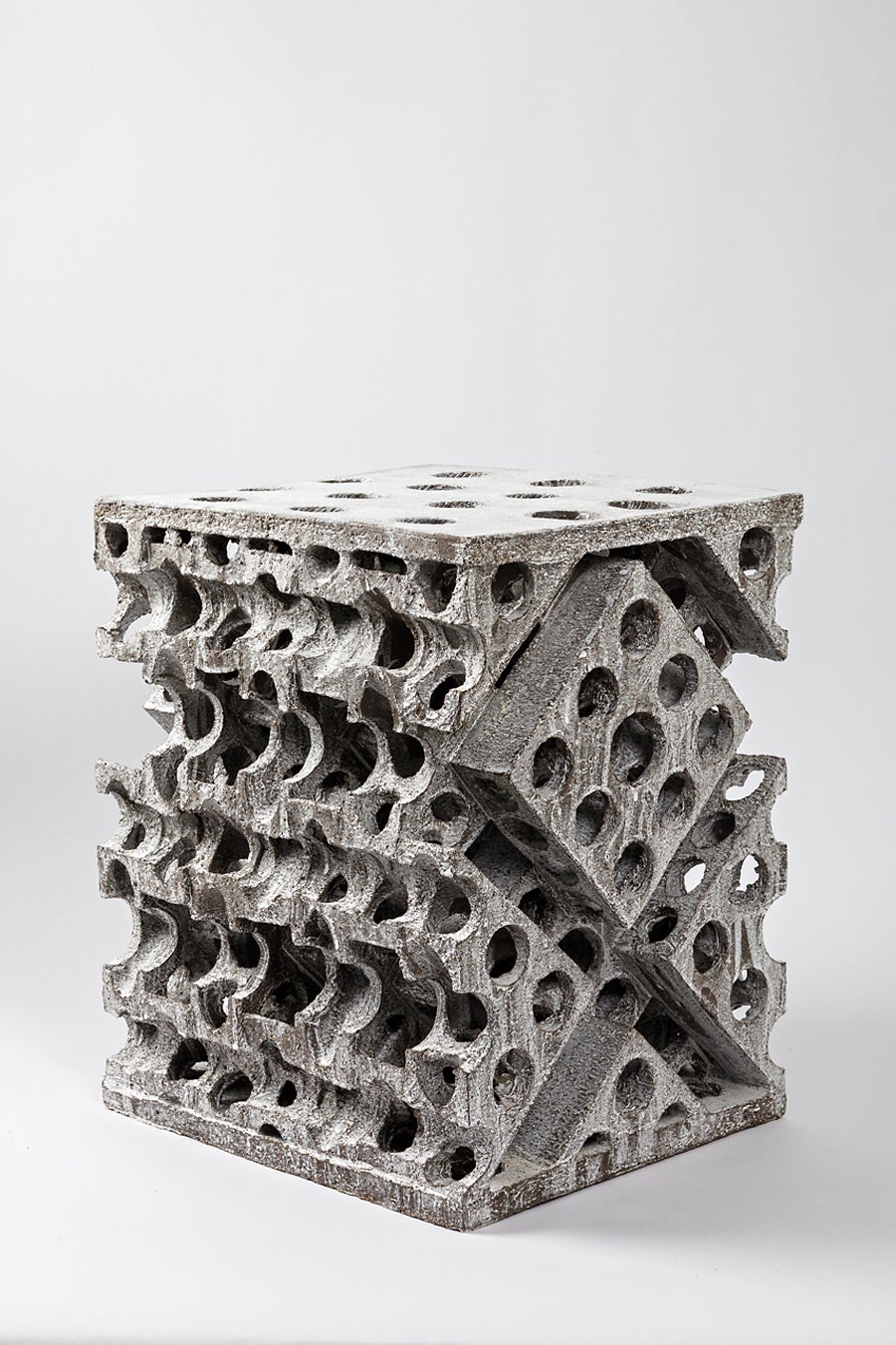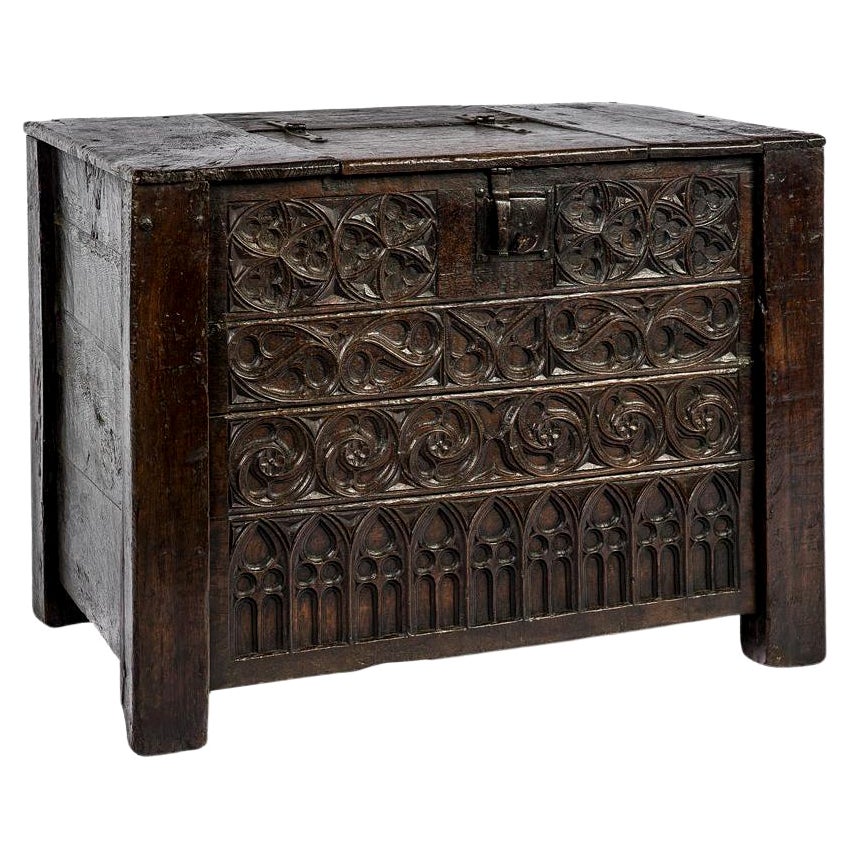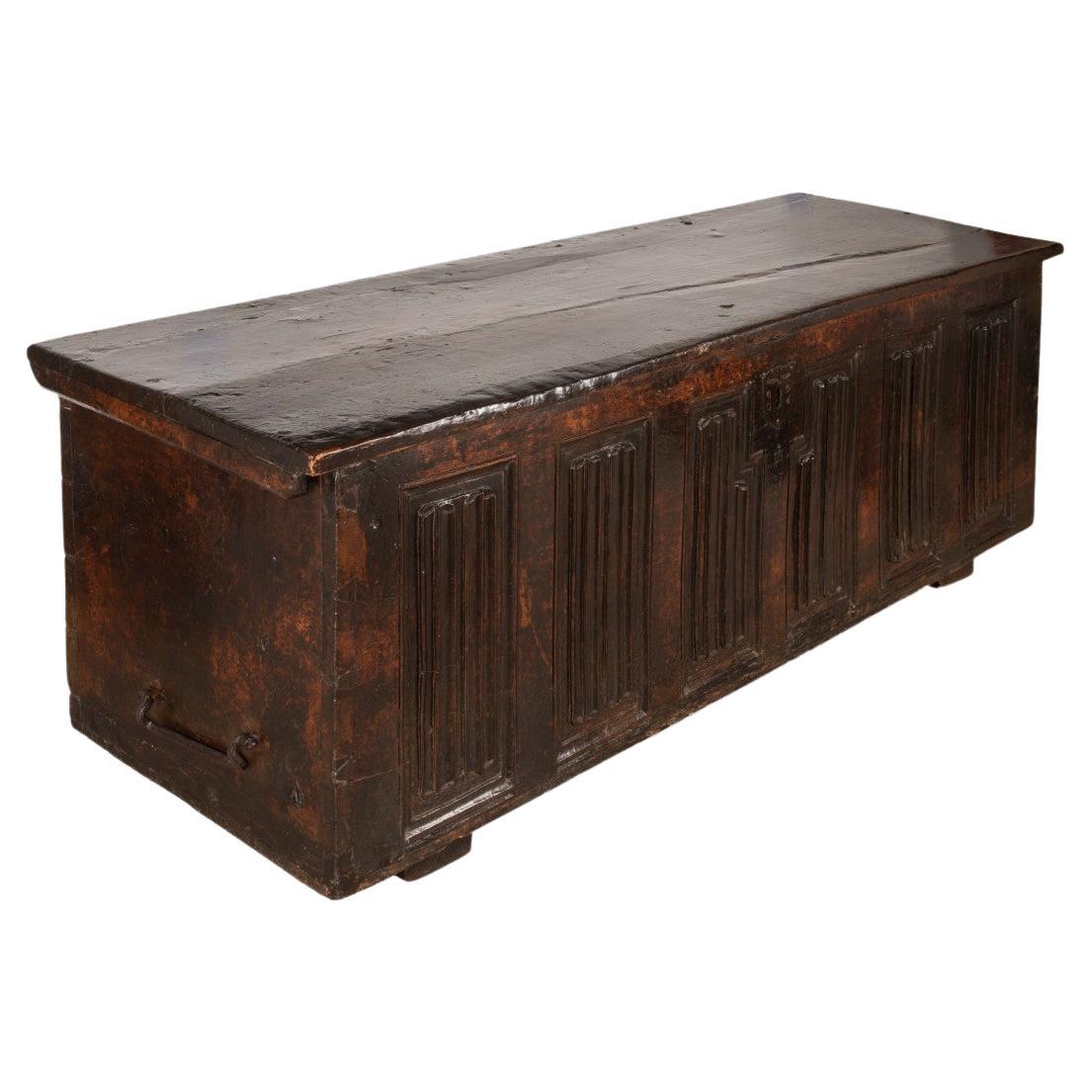Items Similar to Rare Gothic German Oak and Iron Chest Known as "Stollentruhe"
Want more images or videos?
Request additional images or videos from the seller
1 of 5
Rare Gothic German Oak and Iron Chest Known as "Stollentruhe"
About the Item
This large chest stands on high legs prolonging the lateral jambs. Presenting a sober and severe appearance the chest still belongs to the Medieval tradition. The piece is made from very high quality Hungarian wood.
The jambs are joined to the facade and the lateral sides thanks to pegged mortise and tenon securing a great stability and squareness between each parts. The upper lid is made of two joined parts and so is the facade.
The ironwork is present all over the surface of the chest and brings both an additional stability to the construction as well as a rich decor. The lid is secured with hinges. Hinges also run all over the chest in horizontal and vertical lines, ending in a floral motif. The hasp lock is also very ornamental.
Those chests always present important proportions especially when they are made early in the period. This model was very popular in Germany and stayed in vogue until the 16th century. However the feet Gothic decor – vegetal scroll with a thistle and a fruit – allows us to date this chest from the late 15th century.
This chest can be compared to a similar chest kept in the collections of Heidelberg Kurpfalziches Museum.
Chests from this period are extremely rare and this one is extraordinarily well preserved.
- Dimensions:Height: 36.23 in (92 cm)Width: 68.9 in (175 cm)Depth: 24.41 in (62 cm)
- Style:Gothic (Of the Period)
- Materials and Techniques:
- Place of Origin:
- Period:
- Date of Manufacture:Late 15th Century
- Condition:Wear consistent with age and use. Minor losses. Minor structural damages. Minor fading.
- Seller Location:Saint-Ouen, FR
- Reference Number:1stDibs: LU3115327232852

About the Seller
5.0
Vetted Seller
These experienced sellers undergo a comprehensive evaluation by our team of in-house experts.
Established in 2016
1stDibs seller since 2017
146 sales on 1stDibs
Typical response time: 8 hours
- ShippingRetrieving quote...Ships From: Saint-Ouen, France
- Return PolicyThis item cannot be returned.
More From This SellerView All
- French Gothic Linenfold ChestLocated in Saint-Ouen, FRThis Gothic walnut chest, with an exceptional patina, is a good example of furniture intended to be transported during the frequent journeys made by quality people in medieval times....Category
Antique 16th Century French Gothic Blanket Chests
MaterialsWalnut
- Rare and Important German Renaissance ChestLocated in Saint-Ouen, FROakwood Original lock and key This beautiful and robust chest stands on square feet ending in flattened buns. The base presents plain mouldings. The facade is divided in four panel...Category
Antique 16th Century German Renaissance Blanket Chests
MaterialsWood, Walnut
- Rare Gothic Chest of Flamboyant StyleLocated in Saint-Ouen, FRRARE GOTHIC CHEST OF FLAMBOYANT STYLE ORIGIN: NORTHERN FRANCE PERIOD: 15th CENTURY Height : Length : Depth : Oakwood Good condition Original lock This large chest...Category
Antique 15th Century and Earlier Blanket Chests
MaterialsOak
- 15th Century Italian Cassone ChestLocated in Saint-Ouen, FRThis chest stands on a high moulded plinth. It was made from a fine walnut wood and shows good traces of polychromy and gold leaf decor. The facade’s two panels, once colourful, ...Category
Antique 15th Century and Earlier Italian Gothic Blanket Chests
MaterialsWalnut
- Virgin and Child in Majesty, also known as "Sedes Sapientae"Located in Saint-Ouen, FRVIRGIN AND CHILD IN MAJESTY, ALSO KNOWN AS "SEDES SAPIENTIAE" ORIGIN : SPAIN, CATALOGNE PERIOD: EARLY 13th CENTURY Height : 95 cm Width : 32 cm Depth : 28 cm Softwood No polychromy In the middle of the 12th century, the Virgin took her place in churches, seated in Majesty, serving as a throne for her son Jesus. She is then called Sedes Sapientiae, meaning the Throne of Wisdom. At that time, she is not represented for herself and only exists because she has been designated as Theotokos, the mother of God, at the Council of Ephesus in 431, where the divine nature of Christ was proclaimed from his birth. The upright and perfectly hieratic bust of this Virgin and Child in Majesty is seated on a throne-bench. She is dressed in a tunic with a rounded neckline and covered with a fine mantle placed on her narrow shoulders. The supple and natural drapery follows the lines of the body. Large curls frame her face with delicate and regular features, a long straight nose, almond-shaped eyes, and small lips. She supports the Infant Jesus with her left hand. Like his mother, he is dressed in a long tunic, and his little feet are visible in the folds. He holds a small sphere in his left hand, while with his right hand, he gestures in blessing. The face of Christ bears a strong resemblance to his mother’s one, and he gives a slight smile. The position of the Child is no longer as hieratic, nor frontal or central as in the early 12th century, but his face still turns towards the faithful. The 13th century indeed emerges as a period of transition in the artistic domain. The statuary, while retaining certain characteristics still belonging to the habits of the previous century, also develops new formal solutions. As a result, Mary maintains a hieratic and frontal position, while her son shifts to place himself well to the left on her knee. Similarly, while the Virgin seems perfectly still, Jesus, on the other hand, appears much more animated, especially in the positioning of his hands. His left hand holds the orb, and judging by the raised right arm directed towards the faithful, one can easily imagine that he was making a gesture of blessing. The influence of the Sedes Sapientiae from previous centuries still seems particularly prevalent in this work. These few characteristics allow dating this Spanish Virgin...Category
Antique 15th Century and Earlier Spanish Gothic Figurative Sculptures
MaterialsSoftwood
- Late 16th Century Jewelry ChestLocated in Saint-Ouen, FRProvenance : Jean Gismondi collection, before 1973. This important walnut jewelry chest is outlined with a gilt motif and presents a decor imitating basketry. The lid is topped by...Category
Antique 16th Century Italian Renaissance Jewelry Boxes
MaterialsWalnut
You May Also Like
- Chest or Stollentruhe, Early 16th Century, German Gothic, Oak Chest, OriginalLocated in BUNGAY, SUFFOLKThis standing chest is of clamp-front construction, extensively decorated with long, ironwork straps with quatrefoil finials which ‘wrap’ around it, and has an ornate, central lockplate, and front legs with full, height stiles. The ironwork straps and finials are fixed with convex, headed nails: running along the front, five long straps; the two side straps; and the five straps on the top. On the chest front, centrally placed, is a large, iron lockplate with four outer, radiating spade finals in each corner and three, superimposed spade finials (a symbol of nobility) which are pierced with the initials ‘BB’. The lockplate receives a corresponding, external hasp fitted to the lid. Below the floor of the chest, the two front stile legs retain most of their original height. The lid is supported by substantial iron strap hinges that extend right down the back of the chest. Inside the chest at the left end is a shallow, oak till. Construction The chest is of joined, 'clamp-front' construction, reinforced by the nailed, iron mounts. In total it uses ten, oak boards which were riven and planed. The back and front are each formed from a large single plank held to the full height stiles by long, pegged tenons. The sides are also single boards joined into the stiles using long tenons held by dowels, and extend down below the chest bottom, concealing the ends of the bottom boards. The bottom consists of a single board cut into the sides and shallow rebates in the stiles. The front and back boards are dowelled into the bottom boards. The lid which overhangs the sides has a narrow cleat at each end, and consists of one wide plank which has bowed a little as a result of shrinkage. Ironwork : The wrought ironwork straps, lockplate, hasp and lock all appear all appear to be early, and of the same original manufacture and are fixed with convex headed nails. There is mild dark staining of the oak around the iron mounts, possibly because of low tannin content in the oak. Length 172 cm., 67 ¾ in., Height 71.5 cm., 28 ¼ in., Depth 63 cm., 24 ¾ in., Related to: No 900:2-1904 V&A Museum, London. Stadtmuseum Dusseldorf. Decorative Arts Museum Berlin. Museen Schleswig-Holstein & Hamburg. A related example featuring elaborately-carved feet and formerly in the Horsham Museum, West Sussex, sold at Christie's in 2010 for £97,250 and another example, again with carved feet sold at Sothebys in 2006 for £48,000. Literature: A similar example is illustrated in H. Lüttgens, Alt- Aachener Wohnkultur; Ein Rundgang durch ein altes Aachener Haus im Wohnstil des 18. Jahrhunderts, Aachen, n.d., ill. 12, and another comparable iron-bound chests...Category
Antique 16th Century German Gothic Blanket Chests
MaterialsOak
- Rare Late Medieval 16th Century German Wrought Iron Oak Chest or StollentruheLocated in Dallas, TXWe have the pleasure to present a rare late medieval 16th century German wrought iron oak chest or Stollentruhe. This is an early 16th century, ci...Category
Antique 16th Century German Gothic Blanket Chests
MaterialsWrought Iron
- Rare Late Medieval 16th Century German Wrought Iron Oak Chest or StollentruheLocated in Worpswede / Bremen, DEA very impressive Westphalian Gothic chest or ‚Stollentruhe’, Westphalia, Germany, circa 1500-1550. Wrought iron mounted oak, partially carved. The monumental rectangular standing chest with full-height stiles, extensively mounted with wrought ironwork straps terminating in quatrefoil finials which ’wrap’ around the chest edges. These are fixed with convex head nails. The ironwork with some remains of an originally red painted surface. In addition, running along the edges of the lid at the front and sides is a plain iron band, close-nailed. The feet of the two front legs are finely carved on the front face, in low relief with a rectangular arched ’panel’ depicting on the left a lion, on the right a dragon holding each a coat of arms. Regarding the age of circa 500 years, this coffer is in exceptionally good condition, with only smaller restorations. Comparative literature • Baumeier, Stefan, Beschlagene Kisten; Die ältesten Truhen Westfalens, Essen, 2012. • Falke, Otto von, Deutsche Möbel...Category
Antique 16th Century German Medieval Blanket Chests
MaterialsIron
- Rare 15th Century Solid Oak Medieval Dutch Gothic Chest or TrunkLocated in Casteren, NLA very rare chest that was completely made of solid oak from the Netherlands middle ages. It is a joined chest with hand carved geometric gothic front panels. The ornaments used are typical Gothic ornaments such as trefoil, mouchette, and trace. This diminutive chest was probably made in the 15th century Netherlands. It has the typical construction of very early European furniture as is also seen on the German Stollentruhe. The chest has only a small lid with forged hinges...Category
Antique 15th Century and Earlier Dutch Gothic Blanket Chests
MaterialsWrought Iron
- A large and exceptional 15th c. Gothic leather and iron bound travelling chestLocated in PARIS, FRLarge leather and iron bound travel chest, very rare in its dimensions Late 15th century, Northern France Dimensions: h.103 cm, w. 178 cm, d. 77cm ( (H. 40.55 in, w. 70.08 in. d. 30.31 in) Our rectangular-shaped chest opens with a rounded lid. It is entirely covered in leather veneered on a wooden core, and decorated with wrought and crafted iron frames and hinges. It is garnished on all sides with iron hinges cut at the ends of Gothic trefoils. On the facade two lock plates with cut-out cloverleaf borders fitted with a hasp (one missing) attached to the cover. The iron bands serving as reinforcements on all sides as well as the central bands are decorated with plant and floral friezes and geometric patterns. These strips are attached to the wood using daisy-headed nails, typical of the French Renaissance. Given its size and loaded weight, our trunk has four carrying handles: two wrought iron side handles, but also two front handles. The interior has a stretched fabric dating from at least the 17th century, we find on the interior sides of the cover the original raspberry-colored vellum. This is a rare model in leather and iron of very large dimensions. Expensive materials, which were only used on small Gothic boxes (20 cm to 50 cm in length) like those in the public collections of many museums. Large chests exceeding 1 meter in length for the sake of economy and simplicity were generally made of wood sometimes covered with iron cladding. We found a large chest in the collections of the Metropolitan Museum of New York, but still smaller than ours (inv. 47.144, dim. H: 22 1/2" W: 50 1/2" D: 21"). There are also two similar large chests (with flat or slightly domed lids) in the collections of the Barcelona Leather...Category
Antique 15th Century and Earlier French Gothic Blanket Chests
MaterialsWrought Iron
- Spanish late Gothic 16th century and later oak coffer / chestLocated in Troy, NYLift top chest with typical carved Gothic tracery work adorning the front panel, of rather small proportion, beautiful color and extraordinary condition...Category
Antique 16th Century French Gothic Blanket Chests
MaterialsOak
Recently Viewed
View AllMore Ways To Browse
Chest Legs
Large Chest
Chest Over Chest
Oak Chest And Chest
Chest Over
Welling Chest
Chest On Legs
Antique Iron Pieces
Oak Chest With Cabinet
Antique Oak Chest Furniture
Antique Oak Chest Antique Furniture
Antique Oak Storage Chest
Antique Chest With Legs
Large Antique Chest
Large Chest On Chest
Two Over Two Chest
Chest On Chest Oak
German Oak





